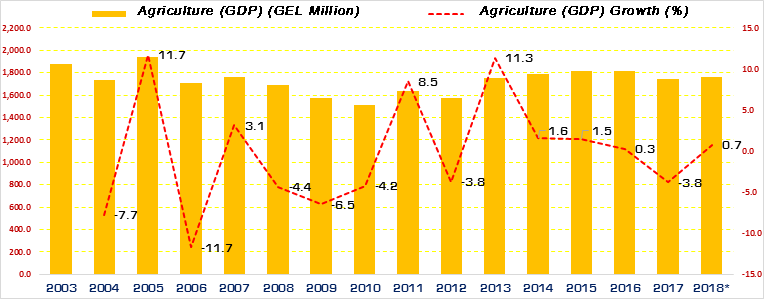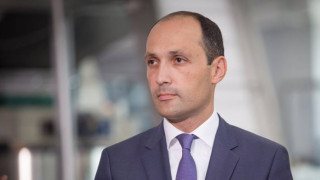Resume: In 2018 as compared to 2013, real agriculture growth only constituted 0.2% (the total agriculture output in that period in constant prices). In 2013-2018, real economic growth constituted 21.5%. Therefore, other sectors of the economy have been increasing much more rapidly as compared to agriculture. In parallel, state allocations for agriculture have been increasing since 2012. Of the 2012 budget payables (the budget was adopted under the United National Movement’s rule), the share of agriculture funding increased to 2.9% whilst it was 0.6% in 2011. The share of funding of the Ministry of Agriculture in the total budget payables exceeded 2% in 2017 and started to decrease in 2018.
In regard to the situation in agriculture in the period of 2004-2012, the real decrease in the agriculture sector was 9%. However, there was no annual decrease in agriculture. In 2005, agriculture increased by 11.7%. In addition, agriculture increased by 3.1% in 2007 as compared to the previous year whilst it constituted 8.5% in 2011. Therefore, agriculture did not show a constant decline in that period.
The part of the Minister’s statement that the agriculture sector could have decreased further if increased agriculture funding had not been allocated under the Georgian Dream is only a theoretical assumption. In 2004-2012 when the funding allocated for agriculture was lower, agriculture decreased both in absolute figures and as a part of the GDP. In 2013-2018 under increased budget funding, the sector marginally increased in absolute figures and only the agriculture to GDP ratio decreased. At first glance, the correlation between the figures partially corresponds to the Minister’s rhetoric. However, to assert the existence of a cause-effect relationship based only on correlation is not appropriate. More in-depth research is required in order to confirm or deny this assertion but this is something which goes beyond the scope of this article. Therefore, FactCheck refrains from discussing this particular part of the Minister’s statement.
Analysis
The Minister of Environment Protection and Agriculture, Levan Davitashvili, spoke about agriculture on air on the Public Broadcaster. The Minister stated (from 05:30): “Since 2013, we have significantly increased agriculture. If we had not spent the money that we spent, agriculture would have decreased because there was a constant decline in agriculture from 2004 to 2012.”
In 2018 as compared to 2013, real agriculture growth only constituted 0.2% (the total agriculture output in that period in constant prices). In 2014-2018, the highest annual growth of agriculture was registered in 2005 and 2013 when agriculture growth constituted 11.7% and 11.3%, respectively, as compared to the previous years. After the 11.3% growth in 2013, the annual agriculture growth rate started to slow down and there was a 3.8% decrease in agriculture in 2017. In regard to the previous year, real agriculture growth constituted 0.7%. In turn as compared to 2013, the real agriculture growth rate is only 0.2% whilst the real GDP growth in the same period constituted 21.5% which means that other sectors are growing more rapidly.
In regard to the agriculture sector dynamic in 2004-2012, the real agriculture decrease was 9.0% in this period. However, the Minister’s statement about a constant decline in agriculture in 2004-2012 does not correspond to the truth because agriculture increased in 2005, 2007 and 2011.
Graph 1: Real Agriculture Indicators, GDP (GEL Million, %)

Source: National Statistics Office of Georgia
In total, the real GDP increased by 102.8% in 2004-2018 whilst agriculture increased by only 1.5%. In the same period, all other sectors of the economy registered substantial growth with agriculture being the only exception. Therefore, it is interesting to see the annual GDP in terms of domain structure and have a look at the share of agriculture in the same period. In 2003, the share of agriculture in the economy of the same year was 17.9% which had been declining annually until 2011. In 2010, the agriculture to GDP ratio was 8.4%. In that year, trade occupied the highest share at 16.8%. In addition to trade, the share of public administration in the GDP increased sharply from 3.8% to 13.0%. In regard to the subsequent period, the agriculture to GDP ratio was 9.4% in 2013 and then resumed an annual decline, dropping to 7.7% in 2018. In the same period, the share of trade continued to increase and reached 17.0% of the total economy. Trade is followed by the processing industry which occupied 10.5% of the 2018 GDP. Apart from the aforementioned fields, the construction and finance sectors increased substantially in terms of their share in the GDP in 2004-2018. Therefore, it is evident that other sectors increase more rapidly in the sectoral structure of the economy as compared to agriculture. Furthermore, it can be said that agriculture did not significantly increase in 2004-2018.
Of note is that the growth of allocations from the state budget for agriculture started in the last year of the United National Movement’s tenure in government (in 2012, funding for agriculture increased substantially). In 2011, state expenditures for agriculture were GEL 39.9 million whilst they increased to GEL 212.8 million in 2012. Of note is that despite the increased funding for agriculture in 2012, the agriculture sector decreased by 3.8% whilst growth constituted 8.5% in the previous year prior to a five-fold increase in funding. In 2012-2016, agriculture expenses in state budget payables had a 2.5% share on average which dropped to 1.8% by 2018. This is planned to decrease further to 1.7% in 2019.
In total and under different amounts of funding in 2004-2018, agriculture growth constituted 1.8% whilst the total GDP growth constituted 102.8%. Despite a sharp increase in budget funding for agriculture from 2012, there was almost no growth in the agriculture sector and the part of the Minister’s statement that the sector could have decreased further if increased agriculture funding had not been allocated under the Georgian Dream is a theoretical assumption only. In 2004-2012 when funding allocated for agriculture was lower, agriculture decreased both in absolute figures and as a part of the GDP. In 2013-2018 under increased budget funding, the sector marginally increased in absolute figures and only the agriculture to GDP ratio decreased. At first glance, the correlation between the figures partially corresponds to the Minister’s rhetoric. However, it is implausible to assert the existence of cause-effect relationship based only on correlation.







